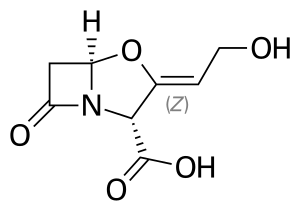Clavam
Clavams are a class of antibiotics. This antibiotic is derived from Streptomyces clavuligerus NRRL 3585.[1] Clavam is produced to form a new β-lactam antibiotic[1]. This class is divided into the clavulanic acid class and the 5S clavams class. Clavulanic acid is a broad-spectrum antibiotic and 5S clavams may have anti-fungal properties. They are similar to penams, but with an oxygen substituted for the sulfur.[2] Thus, they are also known as oxapenams.
An example is clavulanic acid,[3] from which this compound class receives its name.
Clavulanic acid, a type of Clavam, has antibiotic properties. It can be used as a medication to treat a variety of bacterial infections. CLAVAM tablets may be effective for short term treatment of bronchitis, cystitis, sinusitis, otitis media, or skin infections.[4] Clavams are commonly used in conjunction with other antibiotics such as amoxicillin to produce a broader therapeutic effect.
Clavulanic acid strongly inhibits b-lactamase in bacteria, which is associated with its antibiotic properties. Different molecules of the Clavam class have been shown to inhibit the action of several fungal species. 5S Clavams do not have an inhibitory effect on b-lactamase, but are involved in methionine biosynthesis inhibition, making them bacteriostatic agents.[5] Additionally, 5S Clavams may have inhibitory effects on RNA synthesis, which is a common property of anti-fungal medications.[6] Clavams have wide-ranging bioactivity, and may have greater therapeutic use than current research indicates.[7] Because of their activity on b-lactamase, this class of antibiotics can evade antibiotic resistance in bacteria, which is a risk associated with other antibiotics such as penicillins.
References
- 1 2 Pruess, D. L.; Kellett, M. (1983). "Ro 22-5417, A NEW CLAVAM ANTIBIOTIC FROM STREPTOMYCES CLAVULIGERUS I. DISCOVERY AND BIOLOGICAL ACTIVITY". The Journal of Antibiotics. 36 (3): 208–212. doi:10.7164/antibiotics.36.208. ISSN 0021-8820.
- ↑ "Medscape.com". Retrieved 2008-12-29.
- ↑ Chemical Research Laboratory, Oxford University (The Schofield Group). "Antibiotic Biosynthesis, Clavulanic Acid Mode of Action and Biosynthesis". Archived from the original on 2011-06-05. Retrieved 2011-07-25.
- ↑ "Clavam". NPS MedicineWise. Retrieved 2021-04-29.
- ↑ Jensen, Susan E (2012-10-01). "Biosynthesis of clavam metabolites". Journal of Industrial Microbiology and Biotechnology. 39 (10): 1407–1419. doi:10.1007/s10295-012-1191-0. ISSN 1476-5535. PMID 22948564.
- ↑ Röhl, F.; Rabenhorst, J.; Zähner, H. (1987-05-01). "Biological properties and mode of action of clavams". Archives of Microbiology. 147 (4): 315–320. doi:10.1007/BF00406126. ISSN 1432-072X. PMID 3304182.
- ↑ Cierpucha, Maciej; Panfil, Irma; Danh, Tong Thanh; Chmielewski, Marek; Kurzatkowski, Wieslaw; Rajnisz, Aleksandra; Solecka, Jolanta (October 2007). "Synthesis of 3-Substituted-clavams: Antifungal Properties, DD -Peptidase and β-Lactamase Inhibition". The Journal of Antibiotics. 60 (10): 622–632. doi:10.1038/ja.2007.80. ISSN 1881-1469. PMID 17965478.
